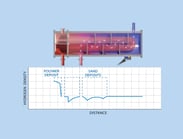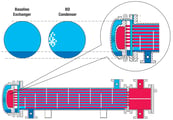A problem plaguing butadiene purification unit operations is the potential for free radical polymerisation, commonly known as popcorn polymer. This popcorn polymer formation can disrupt the operation of the unit by plugging lines, sticking valves, and even physically damaging equipment. Under certain conditions the polymer growth can push apart flanges, rupture lines and even pop the head off exchangers.

These solid build-ups can ultimately lead to leaks to the environment. Given that butadiene is extremely flammable and a suspected carcinogen, these leaks can be especially dangerous.
As an added hazard, the popcorn polymer, if exposed to the air, will spontaneously combust. Popcorn polymer is unpredictable in its formation. It most commonly forms in vapour spaces, but has also formed within liquids. It can form due to the presence of dissolved oxygen in cooling water or due to the presence of bound oxygen such as in rust. Popcorn polymer can basically form at anytime, or it might not form at all. Therefore, careful monitoring of possible growth/rupture points is crucial.
In this latest blog post, we will explain how deploying Tracerco’s specialist scanning technology is an effective way to quickly measure material levels inside vessels and to screen for fouling deposits on vessel walls or in piping. The technique can be applied to survey for fouling or solids build-up along shell walls or in the heads of heat exchangers.
Project Field Test
A petrochemical plant decided to employ Tracerco’s scanning technology for the purposes of monitoring the plant’s condenser. The plant had special concerns about their butadiene condenser since the condenser had a floating head, and there was speculation that popcorn polymer could form in
 between the floating head and shell cover (fixed head). If indeed popcorn polymer had formed in between these points, it could possibly push them apart and allow butadiene out of the system. Due to the complexity of the exchanger geometry, a second exchanger, similar to the condenser in question, was used as a baseline for the study. Both exchangers were scanned and the results were compared as shown in the image. Due to the suspicion of popcorn polymer in the rear end head, it was the main focus of the scan.
between the floating head and shell cover (fixed head). If indeed popcorn polymer had formed in between these points, it could possibly push them apart and allow butadiene out of the system. Due to the complexity of the exchanger geometry, a second exchanger, similar to the condenser in question, was used as a baseline for the study. Both exchangers were scanned and the results were compared as shown in the image. Due to the suspicion of popcorn polymer in the rear end head, it was the main focus of the scan.
Project Analysis
Both exchangers maintained a liquid level of about 10cm. This liquid level appeared as more hydrogen-rich material in the bottom of each head. No other hydrogen-rich regions were detected in the “baseline” exchanger, as was expected. However in the butadiene condenser, a mass of very hydrogen-rich material was detected in the “vapour” space above the liquid level. This material was presumed to be popcorn polymer.
Project Conclusion
Within 24 hours, the condenser was opened and popcorn polymer was discovered in the location the Tracerco crew had indicated. In conclusion, the use of Tracerco’s scanning technology prevented this plant from potentially having an environmental or safety incident.
Do you suspect that you have popcorn polymer buildup in your condenser? Do you want to know what is happening inside of your process vessels? Do you want to avoid unnecessary and costly shutdowns whilst remaining environmentally compliant?
Deploying Tracerco’s process diagnostics scanning technologies is an effective way to quickly measure material levels inside vessels for fouling deposits. Services are rapidly deployed and provide immediate onsite results enabling you to implement the correct solution to the problem both quickly and with minimal disruption to process operations. If you want to learn more about how Tracerco technologies provide insight onsite request more information.
